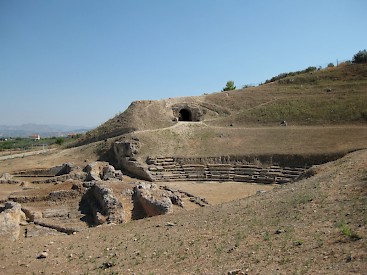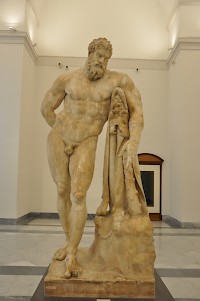Sicyon
Q368628Sicyon (Greek: Σικυών): Greek city on the northern Peloponnese.

Situated in the northern part of the Peloponnese, where the river Asopus flowed into the Corinthian Gulf, Sicyon could only be an important trade center. In its port, merchandise was unloaded, sold, and transported inland, upstream along the river to Phleius. The city itself was built on a platform, about three kilometers from the shore.
History
- According to Pausanius, Sicyon already existed in mythological times, and was subdued by the king of Mycenae, Agamemnon.note
- After the Dark Ages, Sicyon was a Dorian city with the usual division into three tribes: Hylleis, Pamphyli, and Dymanatae. The land was worked by serfs. The city itself was part of the kingdom of Argos.
- In c.676, Orthagoras became tyrant (sole ruler) of Sicyon and made the city independent. He was succeeded by his descendants, most famously by Cleisthenes (first quarter of the sixth century BCE). The Orthagorids ruled for well over a century.note
- Cleisthenes was the main commander of the forces that defended Delphi the First Sacred War (c.600-592),note in which the Athenians (led by Solon), Thessalians, and Sicyonians sacked Crissa, the port of Delphi. This was a major victory: Sicyon destroyed its most important commercial rival in the Corinthian Gulf. Having obtained lots of booty, Cleisthenes built the treasury of the Sicyonians in Delphinote and ordered the construction of a stoa in his hometown.note
- In the mid-sixth century, the Spartans removed Cleisthenes' successor, Aeschines. The city became part of the Peloponnesian League and fought in the Persian War (480-479) against the invaders. Sicyon remained loyal to Sparta, which protected the city's independence against nearby Corinth,
- During the First Peloponnesian War (460-445) between Athens and Sparta, the Athenians attacked Sicyon twice, their trieres having sailed all around the Peloponnese. It supported Sparta during the Archidamian War (431-421), the battle for Syracuse (413), the Decelean War (413-404), and the Corinthian War (395-387).
- When Sparta collapsed after the battle of Leuctra, Sicyon was occupied by Thebes; a new tyrant ruled the city, Euphron.
- The city was part of the Corinthian League; the town had a Macedonian garrison that would eventually side with Ptolemy I Soter, the colonel of Alexander the Great who had started a kingdom in Egypt.
- In 303, however, the city was captured by Demetrius Poliorcetes, and would belong to the Antigonid realms for several decads. The theater was built in these years.
- Sicyon regained its independence during the Chremonidian War (267-261)
- In 251, Aratus of Sicyon seized the city, stabilized its democratic government, and founded the Achaean League; in 243 BCE, he captured the Acrocorinth and convinced Corinth to join the league. The league would last until the Romans subdued Achaea in 146 BCE.
- During the Roman conquest, Corinth was sacked; Sicyon was now president of the Isthmian Games.
- After the refoundation of Corinth and heavy Roman investments in Patras, Sicyon was eclipsed and almost abandoned.
Cultural Center

Sicyon has a great name in art history. It was said that painting was invented by the Sicyonians; this is of course exaggerated, but in the fourth century BCE, Eupompus was a great artist, whose pupils Pamphilus and Apelles were equally famous. Another painter whose name has been recorded, is Melanthius.
Among the sculptors, Dipoenus and Scyllis are famous (c. 580 BCE). Lysippus, who lived in the fourth century BCE, created the Farnese Heracles, the Apoxyomenos, and the portrait of Alexander the Great that is known as the Azara Herm. The Horses of the San Marco in Venice are also believed to be made by Lysippus. His pupil Eutychides of Sicyon made the Tyche of Antioch.